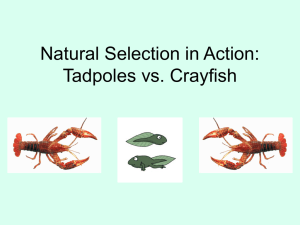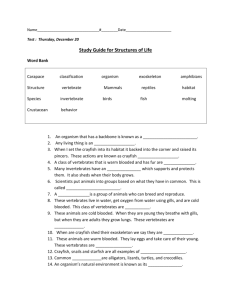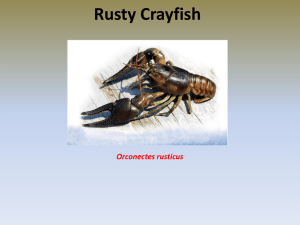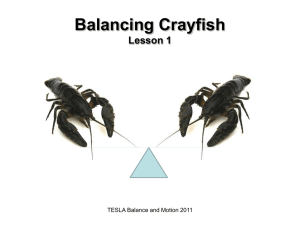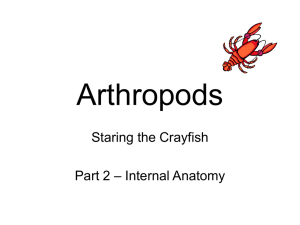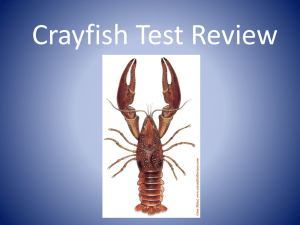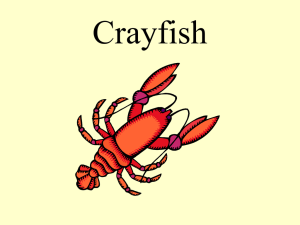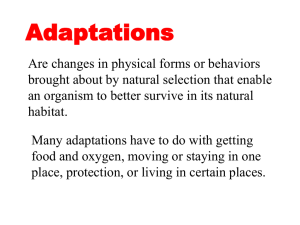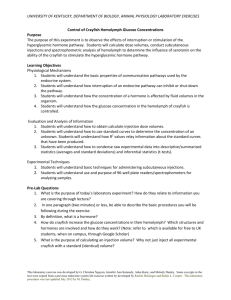A Laboratory Exercise In Osmoregulation By Bonnie Leksrisawat
advertisement
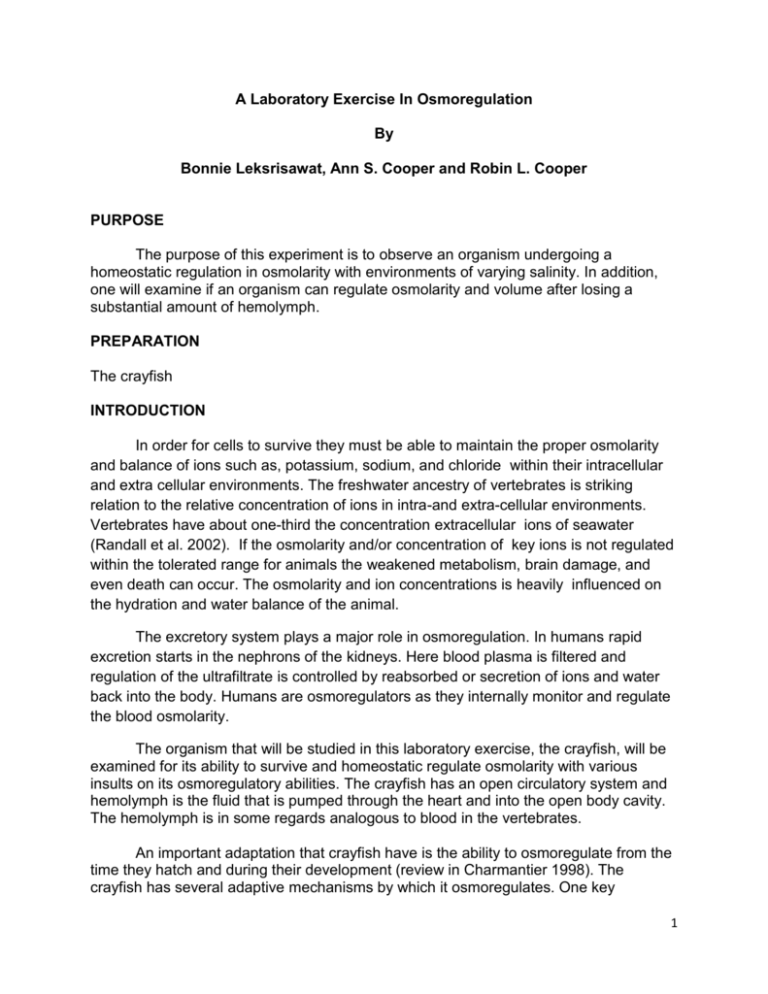
A Laboratory Exercise In Osmoregulation By Bonnie Leksrisawat, Ann S. Cooper and Robin L. Cooper PURPOSE The purpose of this experiment is to observe an organism undergoing a homeostatic regulation in osmolarity with environments of varying salinity. In addition, one will examine if an organism can regulate osmolarity and volume after losing a substantial amount of hemolymph. PREPARATION The crayfish INTRODUCTION In order for cells to survive they must be able to maintain the proper osmolarity and balance of ions such as, potassium, sodium, and chloride within their intracellular and extra cellular environments. The freshwater ancestry of vertebrates is striking relation to the relative concentration of ions in intra-and extra-cellular environments. Vertebrates have about one-third the concentration extracellular ions of seawater (Randall et al. 2002). If the osmolarity and/or concentration of key ions is not regulated within the tolerated range for animals the weakened metabolism, brain damage, and even death can occur. The osmolarity and ion concentrations is heavily influenced on the hydration and water balance of the animal. The excretory system plays a major role in osmoregulation. In humans rapid excretion starts in the nephrons of the kidneys. Here blood plasma is filtered and regulation of the ultrafiltrate is controlled by reabsorbed or secretion of ions and water back into the body. Humans are osmoregulators as they internally monitor and regulate the blood osmolarity. The organism that will be studied in this laboratory exercise, the crayfish, will be examined for its ability to survive and homeostatic regulate osmolarity with various insults on its osmoregulatory abilities. The crayfish has an open circulatory system and hemolymph is the fluid that is pumped through the heart and into the open body cavity. The hemolymph is in some regards analogous to blood in the vertebrates. An important adaptation that crayfish have is the ability to osmoregulate from the time they hatch and during their development (review in Charmantier 1998). The crayfish has several adaptive mechanisms by which it osmoregulates. One key 1 mechanisms is the ability to intake water through the anus. This intake of water is essential in osmoregulation and also essential for the organism to molt its exoskeleton (Vogt, 2002; Muramoto, 1981). Another key adaptive mechanisms is the ability to keep out excess ions from its internal environment because of the low permeability of its integument. Additionally, through its excretory antenneal glands it produces dilute urine (Lienemann 1938; Krogh 1939; Gross 1957; Riegel and Kirschner 1960; Shaw 1960; Lockwood 1962; Potts and Parry 1964; Kerley and Pritchard 1967; Riegel 1970; Bielawski 1971;Fisher 1972; Mills and Geddes 1980; Dunel-Erb et al. 1982,1997; Henry and Wheatly 1988; Péqueux 1995; Wheatly and Gannon 1995; Barradas et al. 1999). Fluid retention is commonly measured by use of body weight in clinical situations for humans (Fagan et al., 2008; Wada et al., 2008) and animals (Boscan et al., 2010). Likewise body weight can be used experimentally to determine fluid loss and gain as a function in an animal’s ability to volume and osmoregulate. Approximately 30% of the weight for a blue crab or a lobster is hemolymph (Gleeson and Zubkoff, 1977; Guirguis and Wilkens, 1995). We assume this percentage also holds to be approximately true for crayfish in these experiments. By extracting a significant amount of the hemolymph and placing the crayfish back into the water, one can determine the amount of time it takes the crayfish to replace the lost hemolymph. In addition, we will examine the conductivity of the various environments in which the crayfish are exposed. If feasible, we will also test the conductivity of the hemolymph from some of the crayfish. Conductivity is a measure a material's ability to conduct an electric current and can be used, for this experiment, as an indirect measure of ionic strength of a solution. Resistance, which is an electrical measurement expressed in ohms, is the opposite of conductivity. Therefore conductivity can be expressed as 1/ ohms. The conductivity measure is related to ionic strength. The measure does not indicate what specific ions are present. However, in these experiments we are using sea water that is diluted and we can use conductivity as a relative measure of the amount of dilution. Also, the goal here is to measure the hemolymph from crayfish after volume defect and exposure to various osmotic environments. As a side note, a change in osmolarity due to non charged substances will not be detectable by this measure in conductivity. In the future we hope to have a vapor pressure osmometer for direct measures of hemolymph osmolarity. PROCEDURES: 1. Choose two crayfish from the ice container and dry it off with a paper towel. 2. Take the initial weight of the crayfish. HEMOLYMPH: 1. Hold the first crayfish behind its claws 2. Position your hand so the tail is spread out. Or have your partner hold the tail down. 2 3. Insert the needle between the thorax (abdomen) and the tail. Be sure not to go towards the middle because this is where the central nerve cord is located. 4. Draw about 3 mL of hemolymph for a large size crayfish (7-10 grams in body weight). Then quickly dab the insertion spot with a paper towel so the blood will clot. 5. Weigh the crayfish. 6. Place the crayfish into the container containing distilled water. 7. Wait 30 minutes 8. Dry the crayfish and take the final weight. Placement in Different Containers: 1. Place the second crayfish (that was previously weighed) into the seawater. 2. Wait 30 minutes 3. Dry the crayfish and take the final weight. QUESTIONS TO ADDRESS: Explain why the kangaroo rat and other desert animals do not have to drink much water. Where does it gain most of its water from? Considering surface to volume ratio, would a larger or smaller mammal loss water more rapidly? Where is ADH (antidiuretic hormone), also known as vasopressin, produced? Label the parts of the nephron: Bowman’s Capsule, distal convoluted tubule, proximal convoluted tubule, efferent arteriole, afferent arteriole, collecting duct, ascending loop of Henle, descending loop of Henle. Describe the function of each part of the nephron: 3 REFERENCES Barradas C., S. Dunel-Erb., J. Lignon, and A. Péqueux. 1999. Superimposed morphofunctional study of ion regulation and respiration in single gill filaments of the crayfish Astacus leptodactylus. J Crustacean Biol 19:14–25. Bayly, I.A.E. 1972. Salinity tolerance and osmotic behavior of animals in athalassic saline and marine hypersaline waters. Annual Review Ecological System. 233-268. Bielawski J. 1964. Chloride transport and water intake into isolated gills of crayfish. Comp Biochem Physiol 13:423–432. 1971. Bielawski, J., 1971. Ultrastructure and ion transport in gill epithelium of the crayfish, Astacus leptodactylus Esch. Protoplasma 73:177–190. Boscan P, Pypendop BH, Siao KT, Francey T, Dowers K, Cowgill L, Ilkiw JE. (2010) Fuid balance, glomerular filtration rate, and urine output in dogs anesthetized for an orthopedic surgical procedure. Am J Vet Res.71(5):501-7. Charmantier G. 1998. Ontogeny of osmoregulation in crustaceans: a review. Invertebr Reprod Dev 33:177–190. 4 Dunel-Erb S., C. Barradas, and J. Lignon. 1997. Morphological evidence for the existence of two distinct types of mitochondria rich cells in the gill of the crayfish Astacus leptodactylus Eschscholtz. Acta Zool 78:195–203. Dunel-Erb S., J.C. Massabuau, and P. Laurent. 1982. Organisation fonctionelle de la branchie d’Ecrevisse. C R Seances Soc Biol 176:248–258. Eichner, Randy. (2009). Six Paths to Hyponatremia. Current Sports Medicine Reports Vol 8, Num.6 : 280-281 Fagan MJ, Avner J, Khine H. (2008) Initial fluid resuscitation for patients with diabetic ketoacidosis: how dry are they? Clin Pediatr (Phila). 47(9):851-5 Fisher J.M. (1972). Fine-structural observations on the gill filaments of the freshwater crayfish, Astacus pallipes Lereboullet. Tissue Cell 4:287–299. Fletcher, C.R. ( 1970) The Regulation of calcium and magnesium in the brackish water polychaete Nereis diversicolor O.F.M. Journal of Experimental Biology. 53, 425-443. Gleeson, R.A., and Zubkoff, P.L., (1977) The determination of hemolymph volume in the blue crab Callinectes sapidus, utilizing 14C-thiocyanate. Comp. Biochem. J. Neurosci. 6, 1560–1569. Gross W.J. (1957) An analysis of response to osmotic stress in selected decapod Crustacea. Biol Bull 112:43–62. Guirguis, M.S. and Wilkens, J.L. (1995) The role of the cardioregulatory nerves in mediating heart rate responses to locomotion, reduced stroke volume and neurohormones in Homarus americanus. Biol. Bull.188, 179–185. Henry R.P. and M.G. Wheatly. (1988) Dynamics of salinity adaptations in the euryhaline crayfish Pacifasticus leniusculus. Physiol Zool 61:260–271. Hill, R.W., G.A. Wyse and Margaret Anderson (2004) Animal Physiology. Sinauer Associates Inc. Sunderland, MA. Pp. 666, 667, 691. Kerley D.E. and A.W. Pritchard. (1967) Osmotic regulation in the crayfish, Pacifastacus leniusculus: stepwise acclimated to dilutions of seawater. Comp Biochem Physiol 20:101–113. Krogh A. (1939) Osmotic Regulation in Aquatic Animals. Cambridge University Press, London. Lienemann L.J. (1938) The green gland as a mechanism for osmotic regulation in the crayfish Cambarus clarkii Girard. J Cell Comp Physiol 11:149–161. 5 Lockwood A.P.M. (1962) The osmoregulation of Crustacea. Biol Rev 37:257–305. Mills B.J. and M.C. Geddes. (1980) Salinity tolerance and osmoregulation of the Australian freshwater crayfish Cheraxm destructor Clark (Decapoda: Parastacidae). Aust J Mar Freshw Res 31:667–676. Musolf, B.E. (2007) Serotonergic modulation of the crayfish hindgut: Effects on hindgut contractility and regulation of serotonin on hindgut. Dissertation (2007). (Downloaded from an open access source at Georgia State University; http://etd.gsu.edu/theses/available/etd-11272007-175638/ ) Muramoto, A. (1981). Effects of eyestalk extracts and ecdysterone on water intake through the anus of the crayfish. Comp. Biochem. Physiol. 69A, 197-203. Péqueux A. (1995). Osmotic regulation in crustaceans. J Crust Biol 15:1–60. Potts W.T.W. and G. Parry. (1964) Osmotic and ionic regulation in animals. Pergamon, New York. Randall, D., Warren, B., French, K.,. (2002) Animal Physiology: Mechanisms and Adaptations. New York. W.H. Freeman and Co. Riegel J.A. (1968) Analysis of the distribution of Na1, K1 and osmotic pressure in the urine of crayfishes. J Exp Biol 48: 587–596. Robertson, J.D. (1953) Further studies on ionic regulation in marine invertebrates. Journal of Experimental Biology. 30, 277-296. Shaw J. (1960) The absorption of chloride ions by the crayfish Astacus pallipes Lereboullet. J Exp Biol 37:557–572. Simon, Eric.MD. Hamrahian, Seyed MD. Hyponatremia, E medicine. Web MD. May 29, (2009) <http://emedicine.medscape.com/article/242166-overview> Susanto, G., Charmantier G. (1999) Ontogeny of osmoregulation in crustaceans. Physiological and Biochemical Zoology 73(2):169–176. 2000. Vogt, G. (2002). Functional anatomy. In Biology of Freshwater Crayfish (ed. D. M. Holdich), pp 53-146. Oxford: Blackwell Science. Wada M, Kusuda S, Takahashi N, Nishida H. (2008) Fluid and electrolyte balance in extremely preterm infants <24 weeks of gestation in the first week of life. Pediatr Int. 50(3):331-6. 6

